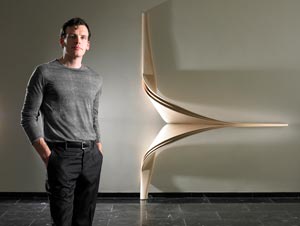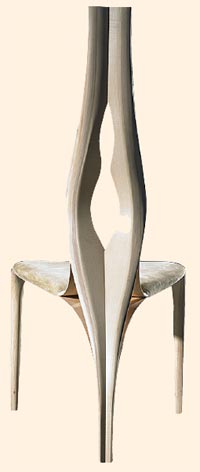Designer Joseph Walsh on his enduring love of wood

Simply sign up to the Life & Arts myFT Digest -- delivered directly to your inbox.
Joseph Walsh, now 33, has developed a reputation for sinuous, ethereal furniture made out of thin layers of wood. Based in County Cork, Ireland, he grew up on a farm and is largely self-taught. His spectacular Enignum Canopy Bed is one of the highlights of Modern Makers, a mixed show of contemporary design at Chatsworth House in Derbyshire.
Q: Tell us about the ideas behind your beautiful Enignum Canopy Bed.
A: The primary idea was to create a piece of furniture that would surround the user, a protected and personal space. The first bed was realised in 2010 at the early stages of my Enignum series when I was exploring the layering and free-form bending of ash. The first bed combined a large sculptural hand-carved form at the head of the bed, and a freeform canopy.
Q: You began making furniture as a boy. What prompted you?
A: I was curious as a boy. I had a keen interest in all sorts of objects and how they were made. I was fortunate to have grown up in a family where making was part of daily life, from my mother making tapestries and clothes, to the farm where I regularly saw machines being made. So making was not a big leap for me.
As a teenager I travelled to see exhibitions and visited workshops. When I was about 16, I came across a book on John Makepeace’s work. That hugely influenced me. I had been seeking something much more than I was familiar with, and his work was mesmerising.
I started to exhibit my work outside Ireland in 2002. In 2008, I had a solo exhibition in New York, showing a body of work from the previous five years. I learnt a lot more about the studio furniture scene in America, I was fortunate to meet some extraordinary characters: for instance, renowned weaver/textile designer and collector Jack Lenor Larsen, who engaged in a dialogue with me over the following months as I began the first Enignum works.
Q: Why wood?
A: Early on it was access. Today, even if sometimes I use other materials, I still love working with wood. It’s a warm, natural material that records its life in its grain patterns. There is much traditional knowledge and mastery, yet it has so much potential for innovation.
Q: What are the inspirations behind your work?
A: The primary idea was to create a piece of furniture that would surround the user, a protected and personal space. The first bed was realised in 2010 at the early stages of my Enignum series when I was exploring the layering and freeform bending of ash. The first bed combined a large sculptural hand-carved form at the head of the bed, and a freeform canopy.
Q: Your pieces have a lightness. They seem less like wood than liquid or silk. How do you create this effect?
A: Mainly what you see are forms that are sympathetic to the material. Model-making is important to me, bending the wood, manipulating it, seeing what I can create three-dimensionally within the material’s potential. This sometimes sends me in unexpected directions but I work in a very free and fluid way.

Q: How do you see your future? Might you evolve into another field?
A: It’s possible that I’ll realise work in other areas, but I only ever want to move at a pace where I can maintain a close proximity to material and making. This year the studio realised my first works in stone and completed commissions that involved collaborating on an entire space. Both were bedroom suites; one in the US and the other in Asia. My main focus will remain individual pieces.
Q: What is the rapport between your work and your Irish origins?
A: Ireland is an inspiring place: the landscape changes throughout the year, with its textures and colours, and there is something very reassuring about the scale of everything and proximity of people; it’s a very human experience.
My team and I are planning to travel to Japan to make a series of pieces at the workshop of a former colleague. I like the challenge of changing the context every now and then. It will be interesting to see how working there that might have an influence on the result.
Q: Two of your chairs frame a painting by John Singer Sargent on the staircase at Chatsworth. How does it feel to see your contemporary pieces mixed with antiques?
A: Chatsworth and the Devonshire Collection are very special in this sense. Everything there is the contemporary work of the time in which it was commissioned. So when I see my work in this collection, I see it among some of the best contemporary work of different eras. For me that is inspiring and a real privilege.
‘Modern Makers’, Chatsworth House, Derbyshire, UK, until December 23. Prices range from £1500 to £124,800. chatsworth.org
Comments